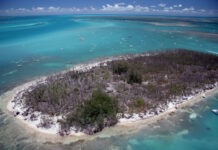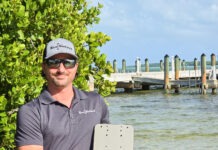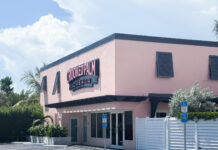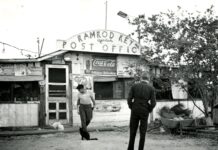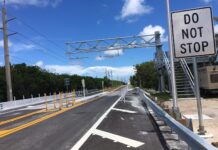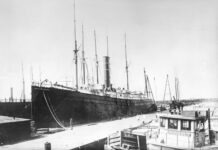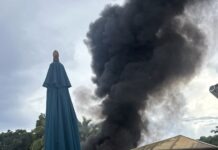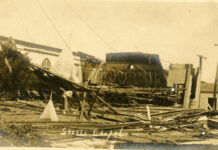
Editor’s Note: This is the first in a two-part series on the steamship City of Washington and its involvement in the Maine battleship incident.
The Spanish-American War, lasting only five months, was fought, primarily, to free the people of Cuba from Spanish domination.
Military campaigns such as Commodore Dewey’s naval victory at Manila Bay and the charge of Theodore Roosevelt’s Rough Riders up San Juan Hill will live forever in the annals of American history. Throughout the war, the American battle cry was “Remember the Maine!”
Today, few remember the Maine. Even fewer remember the steamship City of Washington and her involvement in the Maine tragedy. This involvement makes the City of Washington, in this author’s opinion, the most historically significant shipwreck in the Upper Keys.
The City of Washington, official number 125625, was built in 1877 by John Roach and Sons at Chester, Pennsylvania for the steamship line of F. Alexandre and Sons. She was launched on Aug. 30 of that year, destined for the thriving Caribbean routes, and for a place in American history.
The iron hull, measuring 320 feet overall and 300 feet, 5 inches at the waterline, contained three decks and six watertight bulkheads. The beam measured 38 feet, 4 inches and her depth, 19 feet, 2 inches. Her gross tonnage was 2,685 tons.
The newly built City of Washington arrived at New York on Nov. 18, 1877 to start passenger service to Havana, Cuba, and to Progreso and Campeche, Mexico. The ship served Alexandre Line only briefly. The line was bought out in 1888 by its largest competitor, the New York and Cuba Mail Steamship Company, which had been formed through a merger of the Ward Line and shipbuilders John Roach and Sons.
With Frank Stevens of the Ward Line now installed as master, the steamer continued to ply her trade between New York, Cuba and Mexico.
On April 20, 1889, Morgan Iron Works received an order for new engines and boilers for the City of Washington. On Oct. 14, during sea trials, the City of Washington was said to have given “perfect satisfaction.”
Resuming the regular routes, the newly-refitted City of Washington was able to cut her sailing time greatly. On Aug. 21, 1890 the ship was reported to have docked at New York after sailing from Havana in three days and one hour. At the time, this achievement was described as “remarkable.”
On Feb. 15, 1898, while under the command of long-time master Stevens, the City of Washington lay at anchor in Havana Harbor. Although tensions between the United States and Spain were building with the onset of the Cuban Revolution, Stevens and his crew undoubtedly felt safe and secure, anchored nearly in the shadow of the battleship Maine, sent to Cuba to protect American lives and property.
The Maine, a second-class battleship, measured 319 feet long and displaced 6,682 tons. The battleship was well armed and powerful, bristling with guns and capable of speeds up to 17 knots. The ship’s offset turrets along with forward and aft superstructure made her appearance extremely formidable.
At about 9:10 p.m., the crew of the City of Washington had listened to the mournful sound of the Maine’s bugler blowing taps to signal the official end of the day aboard the battleship. As they reflected on the day’s work and prepared for bed, they could not possibly have suspected that the most important chapter in their ship’s history was about to be written in blood, steel and fire.
At 9:40 p.m. the battleship Maine exploded.
The echoes of this explosion eventually reached into the hearts of every American. The first to hear, and to respond, were the crew of the City of Washington.
The ship was anchored so close to the stern of the Maine that she was riddled with shrapnel. The awning, deck houses and superstructure were damaged by flying debris. Almost immediately, with little thought for their own welfare, the crew of the City of Washington sprang into action, with some lowering boats and others organizing for the care of survivors.
The first two boats lowered were found to be so badly damaged that they were unusable. They were immediately replaced by other, more seaworthy, boats, joining the three surviving boats from the Maine, as well as boats from other nearby ships, in removing survivors from the wrecked battleship. Although rarely mentioned in contemporary American newspaper accounts, the boats and crew of the Spanish Navy cruiser Alfonso XII also assisted in the rescue of survivors from the Maine.
Working frantically in the glare of the burning battleship, the boat crews brought 90 survivors to the City of Washington where a makeshift hospital had been quickly set up in the dining salon. Capt. Charles Sigsbee of the Maine arrived at the City of Washington in one of the Maine’s boats, having been, as is proper in maritime tradition, the last man to leave the sinking battleship.
On the City of Washington, the American sailors were given mattresses, dry clothing and medical care. Some hours later, having first ensured that his crew had been cared for as well as was possible, Sigsbee retired to the captain’s cabin on the City of Washington to compose a telegram informing the Navy of the loss of the Maine and the deaths of 260 of her crewmen.
In the first draft of that telegram, written on New York and Cuba Mail Steamship Company letterhead, Sigsbee stated that the crew of the City of Washington “did great service” to the surviving crewmen of the Maine.
Investigation into cause ensues
Naval investigations conducted shortly after the Maine disaster and again in 1912, when the wreck of the Maine was removed from Havana Harbor, found that the loss of
the battleship was the result of an external explosion, likely a mine. These findings were based largely on the fact that the ship’s lower plates were blown inward and the keel upward. It was not known until many years later that such damage could also be inflicted as the result of an internal explosion.
The first investigation, by a Naval Court of Inquiry with Capt. William T. Sampson presiding, conducted in Havana Harbor aboard the lighthouse tender Mangrove and later aboard the battleship Iowa at Key West, the findings of which were dated March 21, 1898, concluded: “In the opinion of the court this effect could have been produced only by the explosion of a mine situated under the bottom of the ship at about frame 18 and somewhat on the port side of the ship.”
A second board of inquiry, convened by the Navy in 1911 when the ship was raised as part of a harbor clearing project, and led by Admiral Charles Vreeland, confirmed the conclusions of the 1898 court.
Both of these investigations had physical access to the wreck. Later investigations had no access to the wreck but did have access to more modern investigative techniques as well as more than 100 additional years, including two world wars, of experience with explosions aboard ships. Direct access to the wreck was precluded because, following its raising in 1911, the Maine was deliberately sunk in deep water off Havana on March 16, 1912 by the U.S. Navy.
In 1974, the famed Admiral Hyman Rickover, known as the “Father of the Nuclear Navy” for his work in the development of nuclear propulsion on naval vessels, conducted a third investigation of the Maine disaster. This inquiry was privately commissioned rather than official.
Rickover brought in several recognized experts on explosions in ships and they studied the photographs made by the earlier investigation. Their conclusion was that the Maine had been destroyed by an internal explosion, likely the result of a coal fire. They noted specifically that the Maine’s outer keel showed no evidence of blast damage.
Rickover faulted the original investigation for failing to call for testimony from experts, instead relying exclusively on eyewitness testimony which was often inconsistent. He believed that the findings were a foregone conclusion due to several factors. He stated, “The finding of the court of 1898 appears to have been guided less by technical consideration and more by the awareness that war was now inevitable.”
Rickover also stated his belief that if the tragedy had occurred in an American or allied port, the findings likely would have been different.
Writing in regard to the 1911 inquiry, Rickover stated, “It would have been difficult for the board to raise the issue whether the nation and its constituted authorities had made a grave error in 1898.”
Rickover’s conclusion as to the cause of the loss of the Maine was that “In all probability, the Maine was destroyed by an accident which occurred inside the ship.”
The Spanish, of course, had stated from the beginning that the loss of the Maine was due to an internal explosion. Rickover’s conclusions would seem to have proven that they were right all along.
But not so fast; in 1998, the National Geographic Society commissioned yet another investigation. They brought in Advanced Marine Enterprises, a well-respected research company often used by the Navy, to conduct advanced computer analysis and simulations. Their findings concluded, “It appears more probable than was previously concluded that a mine caused the inward bent bottom structure and detonation of the magazines.” The controversy continues to this day in naval circles.



